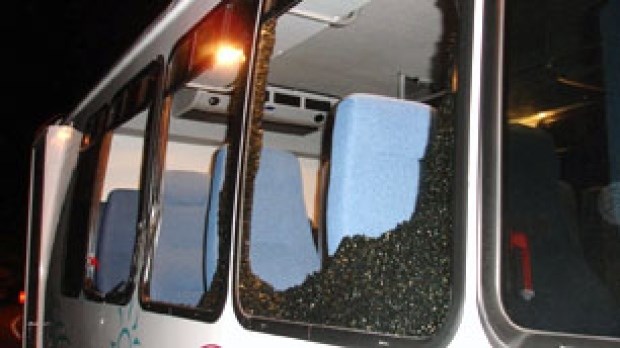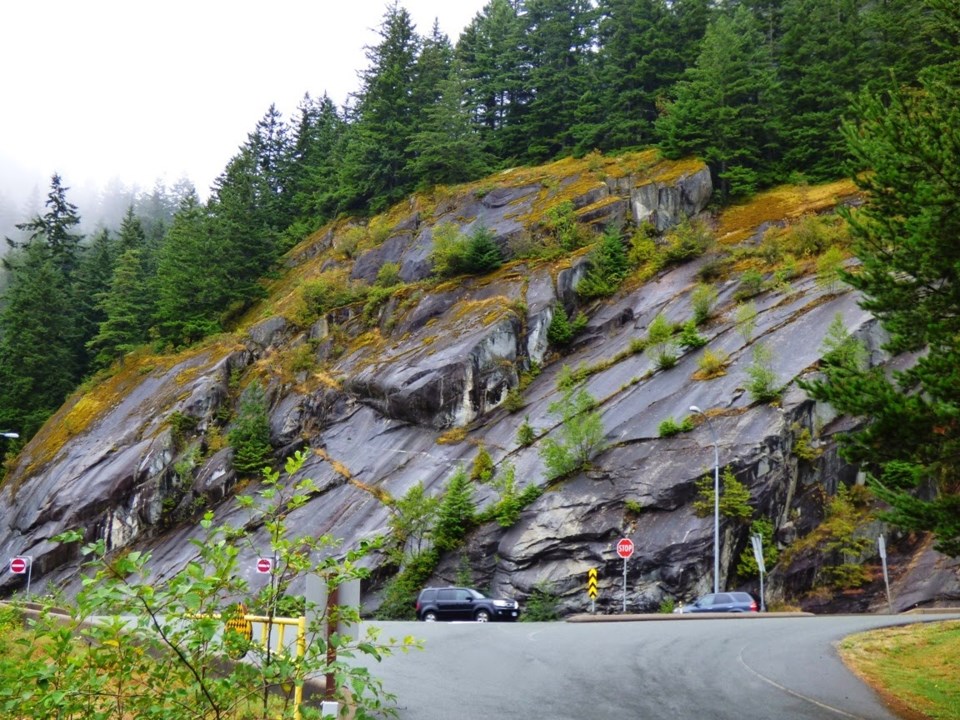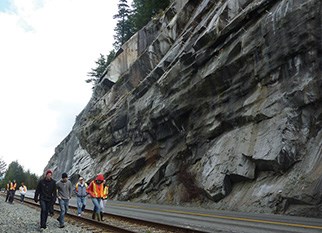This year marks the tenth anniversary of the July 2008 rockslide near Porteau Bluffs that brought down a 10-metre-high wall of rock onto the Sea to Sky Highway.
Miraculously, no one was hurt in the slide, though a 24-passenger bus narrowly avoided being caught in the avalanche of 16,000 cubic metres of boulders that came down near midnight.
The bus windows were blown out and its sides were punctured.
Squamish’s Andrea Bourgh was a flagger working the night shift on the highway during the $600-million expansion project done in preparation for the 2010 Winter Games.
She was on the Vancouver side of the slide but had been set to go up the highway to flag at Furry Creek.
“The only reason I wasn’t right where it happened was because of two extenuating circumstances,” she recalled to The Chief, adding she couldn’t remember exactly what slowed her down, but guesses it was a bathroom stop or she had to wait to be relieved by a co-worker before she changed locations.

“I got the call that there was a huge slide,” she said, adding that two of her friends were in one of the first cars to arrive at the slide area after it occurred.
“I was just so thankful that they weren’t under there.” Drivers stopped due to the slide were frustrated that they couldn’t get through to their destination, she said. But for Bourgh the issue was much bigger.
“At that point, we didn’t know if there was anyone under there. It wasn’t until they cleared it that they really knew.”
She lived in Vancouver at the time so she could get home, but many of her co-workers couldn’t get back to their homes in Squamish. “All the girls who worked with me were all stuck in Vancouver. So they had to come stay with us.”
Her co-workers didn’t get home until about a week later after the rock was cleared.
“It goes through my brain every time I go down the highway,” she said of the slide. “Not many people respect the fact that it is just a mountain highway.”
There is a long history of rockslides at about the same location, at Porteau Bluffs.
Between when the highway opened in 1958 and the 2008 slide, there were four other significant slides at about the same location. People died as a result of the incidents in 1969 and 1991.
So, could it happen again?
Since 2009, traffic on the highway has increased by about 24 per cent with an average of 19,000 vehicle trips currently made each day through Lions Bay and Squamish, according to the Ministry.
A representative with the Ministry of Transportation and Infrastructure told The Chief that the Sea to Sky Highway is a “state-of-the-art highway design, with safety as the highest consideration.”
The ministry carries out a $400,000 per year safety program. The program includes monitoring the slopes to mitigate rockfall hazards, and stabilization projects to reduce potential risks, a communication representative said in an email to The Chief.
“The ministry has invested more than $1.1 million in improvements to the Sea to Sky Highway this year [2017], boosting safety for motorists and cyclists. This includes a new median barrier through the community of Lions Bay,” the email stated.

Geologist Steve Quane, a physical sciences tutor at Quest University, says he thinks about the vulnerability of the Porteau Bluffs every time he drives by them.
He says despite the work done by the province, another slide is likely in the area at some point.
“But if you think about the amount of rock so adjacent to the highway, I don’t know that we can engineer out way out of potential rockfall,” he said.
Large linear cracks in the rock make the bluffs particularly prone to slides, according to Quane.
“What you see as you are driving right next to it are very large fractures,” he explained.
“They are through-going for one, so quite extensive and they are actually sloped down toward the road.”
If anything gives way above, rock is prone to come down onto the highway, he added.
The fractures were created over a long period of time, through a process of, put simply, exfoliation.
“Almost like the peeling of an onion,” he said. “The rocks become weaker as they are exposed on the earth’s surface and then our normal weathering processes — wind and water and ice, freeze-thaw — start occurring in these weaknesses and this is where things become more problematic, as gravity acts on them.”
Mayor Patricia Heintzman was out of town at the time of the 2008 slide but remembers the resulting concern over the highway not being in shape for the Olympics.
“Everyone was freaking out that if this should happen during the Olympics, it would crash the whole experience,” she recently recalled, adding that the safety of the highway, especially at Porteau Bluffs has been a long-standing issue. “Those slabs are on quite an angle, almost stacked, and so it is a precarious geological zone — period.”
Heintzman acknowledged a lot of money and effort was spent to improve the Sea to Sky Highway and to bolster the emergency ferry terminals at Darrell Bay and Porteau Cove.
The only other option for the province would have been to route the road through the mountains, which wasn’t very practical.
Heintzman echoed the sentiment of Bourgh that drivers need to respect the power of nature and the landscape along the highway.
“People have to realize this is a mountain, ocean highway. It is twisty and turny. It gets inclement weather; it fogs over at night, the bridges can be icy. You are in a mountain environment, but because it is such a wide almost parkway-type highway now, people sort of take it for granted. But it is a mountain highway — a tremendously challenging road and people need to respect that.”



